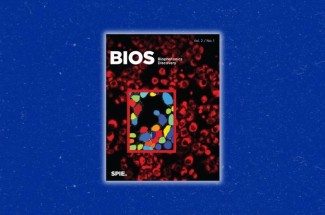UK researchers develop groundbreaking microscopy technique to study cancer

Researchers at the University of Kentucky have introduced a novel microscopy technique that could revolutionize cancer research by providing an accessible, cost-effective way to study how cancer cells adapt to treatments.
The National Institutes of Health-funded study, published in Biophotonics Discovery and featured on that publication’s cover, underscores its importance and potential impact on the field of oncology. It also highlights a significant advancement in understanding treatment resistance at the single-cell level.
“By repurposing standard lab equipment, we’ve turned a simple microscope into a powerful tool to decode cancer’s survival tactics,” said Caigang Zhu, Ph.D., an associate professor in the F. Joseph Halcomb III, M.D. Department of Biomedical Engineering in the UK Stanley and Karen Pigman College of Engineering, who led the study. He is also a member of the Molecular and Cellular Oncology Research Program at the UK Markey Cancer Center.
“This opens doors for researchers everywhere, and these tools can be accessible without specialized resources, accelerating global research into metabolic reprogramming,” said Zhu.
Cancer cells often undergo metabolic reprogramming — a process where they alter their metabolism to survive and resist therapies designed to kill them. This phenomenon is a major challenge in developing effective cancer treatments.
Existing methods to study these changes are often expensive, complex and destructive to the cells being analyzed. The new approach developed by Zhu, along with a team of researchers at UK and Wake Forest University’s School of Medicine, overcomes these barriers.
Using a standard fluorescence microscope paired with imaging software, the researchers created a technique that allows for detailed analysis of metabolic changes in individual cancer cells without costly equipment or invasive procedures.
Their work focused on head and neck squamous cell carcinoma (HNSCC) — a type of cancer known for its resistance to radiation therapy. Squamous cells line the body’s skin, mucous membranes and other tissues, including the mouth, throat and voice box. These types of cancers make up 4% of cases in the U.S., according to the National Cancer Institute.
Treatment for head and neck cancer may involve surgery, radiation therapy, chemotherapy, targeted therapy, immunotherapy or a combination of these approaches.
The team discovered that radiation treatment triggers significant metabolic shifts in HNSCC cells, particularly through the activation of a protein called HIF-1α. This protein enables cancer cells to adapt to low oxygen levels — a common condition in tumors — and contributes to their resistance.
“Our work exposes a critical weakness in treatment-resistant cancers: their metabolic adaptability. By targeting the HIF-1α pathway, we’ve shown it’s possible to ‘starve’ resistant cells of their defenses and make them more sensitive to radiation,” said Zhu.
The innovative method uses commercially available metabolic probes and requires minimal expertise, making it accessible to a broader range of researchers.
Zhu emphasized that this work was inspired by the challenges his team faced in accessing expensive metabolic tools in the past.
“Our findings are exciting because we now have a cost-effective approach to study cell metabolism at the single-cell level,” Zhu said. “Cancer doesn’t always respond uniformly to therapy — that’s why single-cell analysis matters. This technique lets us see, for the first time, how individual cells rewire themselves under pressure, offering a roadmap to outmaneuver resistance.”
This breakthrough has far-reaching implications for cancer research. By enabling detailed single-cell analysis of metabolic changes using readily available tools, scientists can better understand and combat treatment resistance across various types of cancer.
Read the full issue of Biophotonics Discovery featuring this work online.
Research reported in this publication was supported by the National Institute of Dental and Craniofacial Research of the National Institutes of Health under Award Number R01DE031998, by the National Institute of General Medical Sciences of the National Institutes of Health under Award Number R01DE031998 and by the National Cancer Institute of the National Institutes of Health under Award number P30CA177558. The content is solely the responsibility of the authors and does not necessarily represent the official views of the National Institutes of Health.




